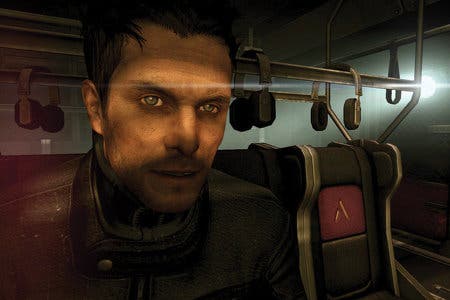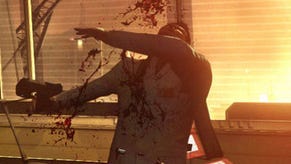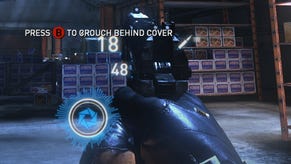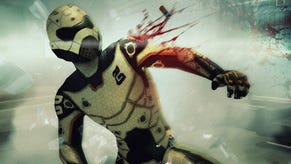Face-Off: Syndicate
Corporation taxed.
| - | Xbox 360 | PlayStation 3 |
|---|---|---|
| Disc Size | 7.1GB | 7.0GB |
| Install | 7.1GB (optional) | 1833MB (mandatory) |
| Surround Support | Dolby Digital | Dolby Digital, DTS, 5.1LPCM, 7.1LPCM |
The idea of the classic real-time strategy franchise rebooted as a first person shooter may well upset die-hard purists, but the fact is that Riddick/Darkness developer Starbreeze has handed in an entertaining action game featuring solid gunplay and challenging AI. However, single- and multiplayer modes are distinctly fractured from each other, and there's a distinct sense that some of the best ideas are rarely explored to the fullest extent of their potential.
For us, the highlights are the DART 6 augmented enhancements which allow you to dispatch your enemies in a small variety of interesting ways, along with the striking visual style of the environments and the accomplished lighting model. But elsewhere, the experience feels uneven: haphazard boss encounters and repeated waves of enemies introduced to artificially lengthen the experience only serve to annoy the player rather than engrossing them further into the action.
From a technological perspective, the visual representation of the sleek, highly stylised sci-fi setting is handled beautifully, and the engine powering the game appears to be well optimised in terms of performance across both console platforms. Starbreeze's proprietary engine has traditionally favoured the 360's architecture, taking advantage of the increased memory bandwidth and higher pixel fill-rate to deliver superior resolutions along with higher quality artwork. However, as our head-to-head video demonstrates, Syndicate is by far the developer's closest multiplatform release to date.
"Starbreeze's proprietary engine has been significantly retooled, making this the closest cross-platform title the developer has produced."
The in-house engine powering the game has undergone a number of dramatic changes under the hood since it was last used in The Chronicles of Riddick: Dark Athena, allowing for much closer parity between platforms. For example, the code used for cloth simulation is now offloaded onto the SPUs on PS3's Cell processor, along with parts of the physics and DartVision code, taking advantage of the PlayStation 3's CPU-specific strengths. Similar optimisations have also taken place on the 360, ensuring that both versions are as close as possible. According to Starbreeze, these tweaks are exactly why the engine is able to run in high definition on both platforms, compared with The Darkness and Riddick, which both used sub-HD framebuffers on the PlayStation 3.
Syndicate renders in 720p on both platforms and, in common with many recent games, forgoes the use of MSAA (multi-sampling anti-aliasing) in favour of a post-process edge filter, which sees differing implementations on each console. Overall image quality is variable at best, but there are times when the filter looks good and works well with the artwork, although objects in the distance are often plagued by visible 'jaggies'. These edge artifacts are more noticeable on the PS3, where the filter is less effective at successfully smoothing over the various elements of the scene.
The impression we get here is that both versions have the appearance of a game in which the extensive use of post-processing effects - such as a grain/noise filter and depth of field - have almost as much of an impact in tackling the 'jaggies' as the post-AA itself, although this can dramatically change on a per-scene basis depending on a number of factors, from sub-pixel issues to the level of post-processing in play.
PS3 Dynamic Resolution Scaling
Beyond this, there is another key difference between the two games where the image quality is concerned. Interestingly, the PS3 version often looks visibly softer than 360 game. The cause of this appears to stem from the use of a dynamic framebuffer, where the resolution is temporarily lowered on a per-frame basis in order to maintain performance. The idea here is simple: less pixels to render means that new frames can be generated faster, so when the engine comes under stress it can still keep within that 33ms threshold required for a sustained 30FPS update. The effect works well enough that it's not so noticeable during gameplay and is only really picked up when analysing video captures.
This isn't the first time we've seen this in a console title: id software's Rage and WipEout HD utilised similar techniques for the same reasons, while Starbreeze themselves first implemented use of dynamic buffers way back in 2004's The Chronicles Of Riddick on the original Xbox. Given that heavy use of post-process effects makes it quite hard to see when the switch occurs in Syndicate - outside of extended drops in resolution, usually confined to the odd cut-scene - the technique works well and allows for performance to be closely matched across both formats without visibly compromising image quality quite so obviously.
"Syndicate on PS3 can look softer than its 360 equivalent leading us to believe that resolution is dynamically adjusted to maintain performance."

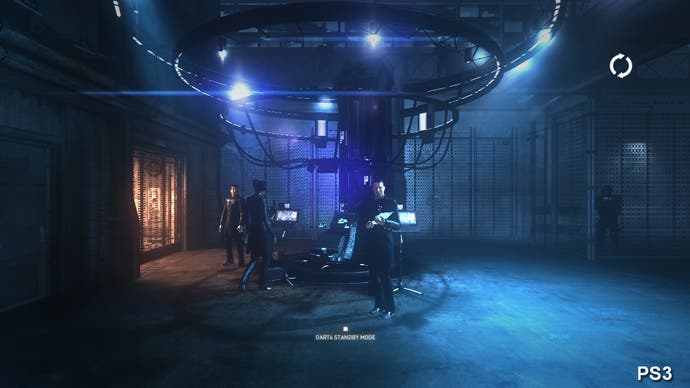
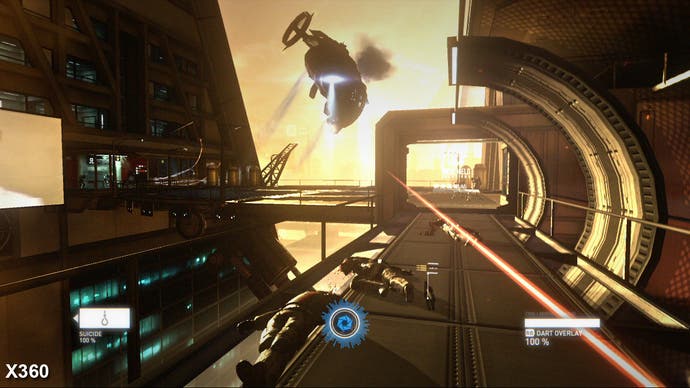
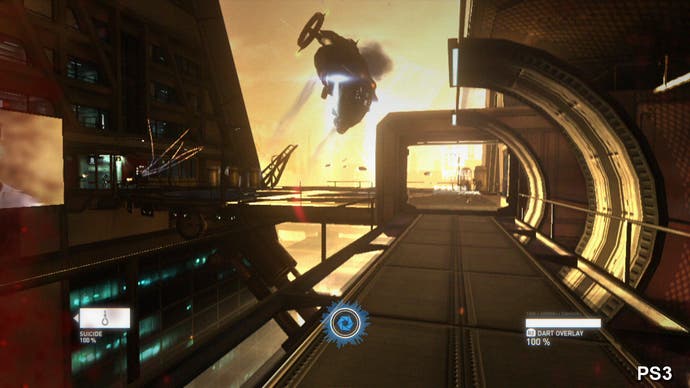
In terms of the game's graphical make up, the bulk of the artwork is identical and full resolution alpha buffers are present on both PS3 and 360, ensuring that the overall presentation is, for the most part, like-for-like. However, there are a few lower resolution textures dotted about on the PS3 game from time to time, while the level of anisotropic filtering is also dialled back resulting in a reduction in clarity when it comes to viewing artwork from a distance. This isn't such a big deal across the run of play, but we did find that the PS3 version isn't quite as effective in streaming from the optical drive as its 360 equivalent.
Firstly, mip-map transitions between detail levels are more aggressive on the Sony platform. Low resolution textures appear on-screen for a few seconds longer, and higher quality artwork often pops up as the engine struggles to stream in new assets fast enough. Secondly, slightly lower LOD models are also used in some of the cut-scenes found throughout the game, with less geometry and lower resolution textures on the characters and other objects.
Curiously, we see similar issues with regards to LOD transitions on the 360, though to a lesser extent, which seems to indicate that streaming assets into RAM is the main issue here, with the PS3's more restrictive memory set-up perhaps posing more challenges to the developer.
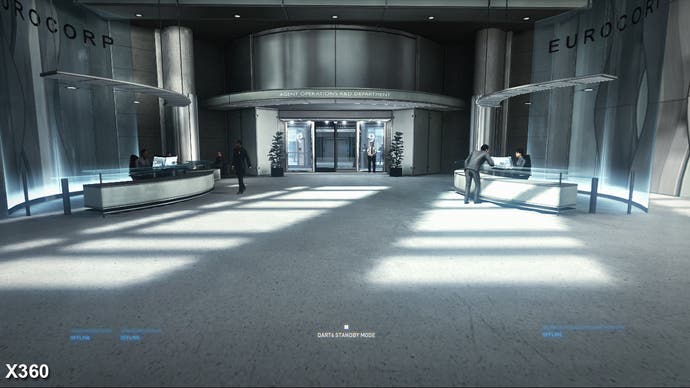
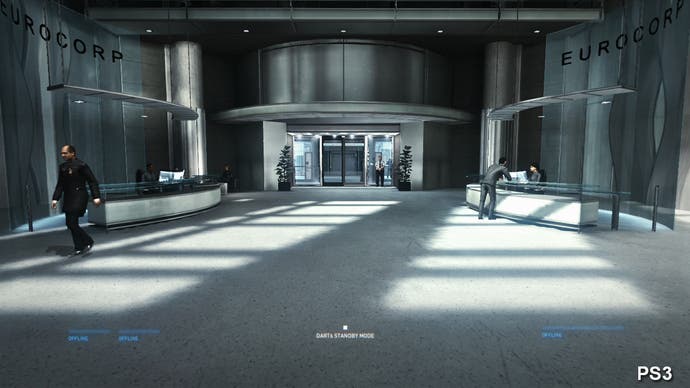


"Post-processing plays a big part in how Syndicate looks, taking the clean, high contrast environments and enhancing them with a gritty futuristic feel."
While the gap in quality is far from jarring, there's a general feeling that things aren't quite as refined on the Sony platform in this regard, and this is best demonstrated with some intrusive hiccups at various points as the engine struggles to load in new graphics data when entering new areas, or when there are sudden changes in environmental details.
Thankfully this is the only time when gameplay is affected in any way, but the results are particularly unsightly - a large amount of frames are dropped in quick succession as the engine's streaming system attempts to catch up with the load, resulting in heavy juddering and a reduction in controller response. Both versions are affected, but the 360 acquits itself better here, with fewer frame drops and shorter periods of judder.
Post-processing plays a big part in how Syndicate looks, taking the clean, high-contrast environments and enhancing them with a gritty futuristic feel. It adds a lot of atmosphere to the game, and perfectly suits the digitally driven, oppressive world Starbreeze has created.
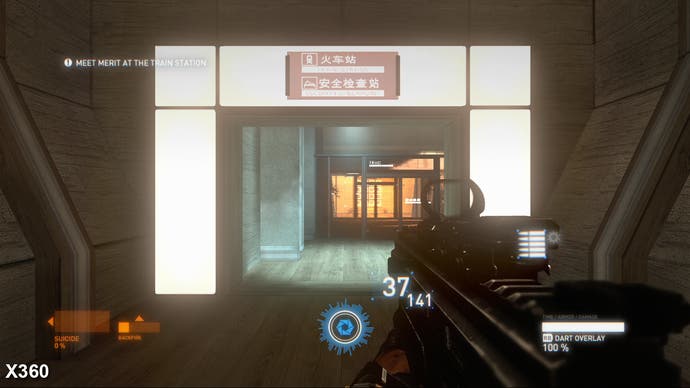

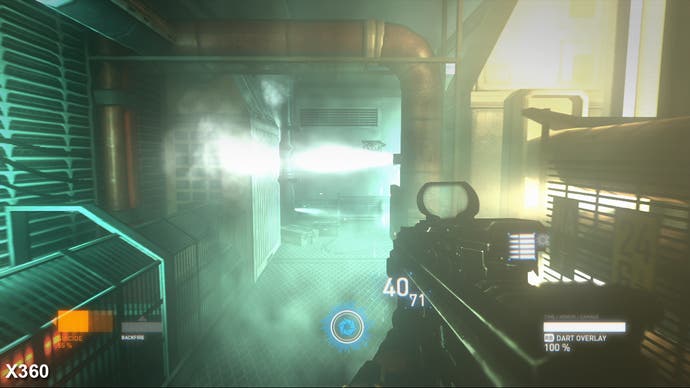

Film grain/noise filters and use of camera motion blur create a cinematic look to the proceedings, with the latter helping to give the impression that the game is actually running at a slightly higher frame-rate than it actually is - the process of blurring frames together translates into smoother motion when interpreted by the human eye. Motion blur is rendered in a lower precision on the PS3, visible by the darkened radius of the effect, which also reveals some low resolution artifacts - less detail is preserved in the radius of the blur, although the rest of the effects work is equally represented on both formats.
Unleashing the Beast
Syndicate's lighting system is one of the most impressive technological accomplishments of this new game. This is something that has always looked great in Starbreeze's previous titles, but new technology has taken it to new heights, helping to define the game's unique aesthetic.
"Syndicate's lighting tech delivers some of the most visually striking scenes in the game, generating a unique atmosphere that makes the game stand out from the crowd."
Syndicate is the first title to use Starbreeze's in-house Beast global illumination system, which uses a combination of pre-backed light sources and shadows in combination with real-time elements to replicate the way lighting behaves in real life - from what we gather, this is similar to Epic's own Lightmass solution, used in Gears of War 3. Complementing this is the use of dynamic light sources - from gunfire and explosions - along with HDR and bloom, and the inclusion of real-time light-shafts. All these different factors are responsible for delivering some of the most visually striking scenes throughout the game, generating a unique atmosphere that makes Syndicate stand out from the crowd.
The fact that much of the lighting is pre-backed also has a positive impact on shadow quality. As these are rendered offline, they require fewer GPU resources. Many environmental shadows have a soft and dithered appearance and look identical on both platforms. When it comes to the real-time shadows there is an offset bias at work on the 360, which results in some of these elements of the scene protruding outwards slightly from the environment. Shadowing is also bugged in a few places on the 360 causing these elements to unnaturally extend out from the floor and walls when in some cases they shouldn't be there at all. In comparison, there are no such issues to be found anywhere on the PS3, which appears a little more refined in this regard.
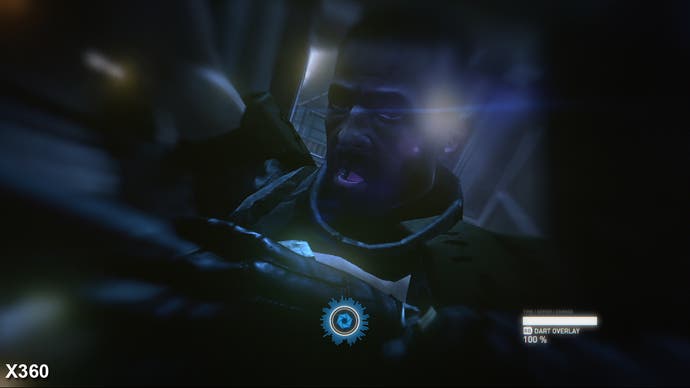
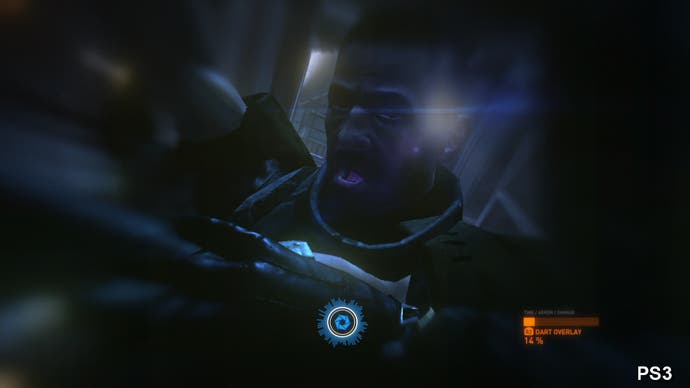

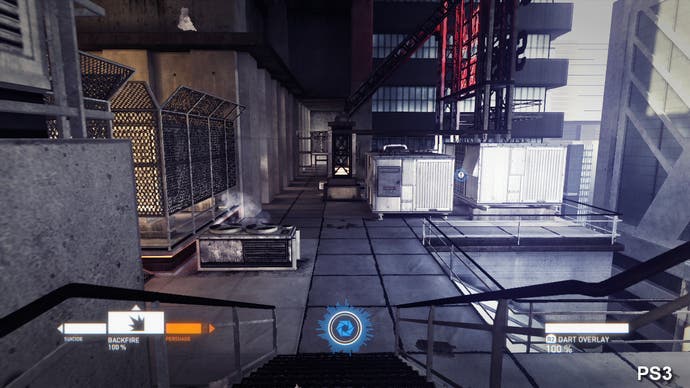
On the whole, Starbreeze has done a great job in maintaining parity across both consoles with the many key engine optimisations having a positive effect on the PlayStation 3 code, where the tech previously struggled in Riddick and The Darkness. While there might be a few differences with regards to the game's artwork and general streaming performance, this is mitigated by mostly identical texture work and impressively solid frame-rates.
There's a real sense that both versions are equally polished where hitting the targeted 30FPS update is concerned. Bearing in mind the sophistication of the engine, the wealth of intensive visual effects, and the quality of the lighting on offer, this represents a considerable technological feat.
Performance profiles differ across both platforms, though the overall outcome is very similar: both versions run consistently at 30 frames per second with hardly any drops. Even when the engine is hit hard with longer draw distances and multiple enemies on screen, we see both platforms coping very well when the rendering load is pushed.
On the 360 we see the engine dropping v-sync when the frame-rate dips below its intended target, thus resulting in a few pockets of very occasional tearing. In comparison, the PS3 version maintains v-sync throughout, instead dropping a few frames when the engine is put under stress. Both solutions work well overall - neither frame-rate drops nor tearing negatively impact the overall experience.
In the end, the two differing approaches give us a similarly 'locked' 30FPS experience for the most part, with any lapses in smoothness or torn frames having no impact on how well the game plays, or for that matter, how it looks. Tearing is only really noticeable when activating the 'DART-6' overlay, and often goes unseen given the initial bout of screen distorting effects encompasssing the display when this happens, while dropped frames on PS3 are few and far between during gameplay - as good an endorsement as any for the dynamic resolution implementation.
While the effects of using this technique aren't particularly visible during gameplay - outside of a few more "jaggies" and a little bit of softness here and there - the implications are more obvious during some of the cut-scenes.
"Starbreeze uses different technologies on PS3 and 360, but both maintain a remarkably solid 30 frames per second update."
Generally speaking, performance in these sequences matches the stability and quality of gameplay, but when the engine is strongly challenged we find that frame-rates take a heavy hit for a few seconds on the PS3, despite the framebuffer resolution also being lowered to counteract the increased rendering load. In comparison, more frames are torn on the 360 compared to the gameplay tests, but the action is considerably smoother in the scenes that the PS3 struggles with.
The bottom line is that Syndicate is an excellent performer on both consoles. The small instances of tearing on the 360 and the rare dips in frame-rate on the PS3 never affect your enjoyment of the game. However, one area that does feel ripe for improvement is the set-up of the controllers - it feels rather laggy on both formats, but more so on the PlayStation 3, where the differences in dead zone, stick range and travel between the controllers' analogue sticks gives the 360 an initial advantage. This can be adjusted in the menus, helping to dilute the issue, and while this doesn't result in identical performance, it does make lining up shots quicker and easier to do.
Miscellenia: Controls, Video Sequences and Audio
There is an argument that the heaviness in the controls is in there by design. Besides being augmented with digital enhancements, in Syndicate's world these aren't superhuman characters you are dealing with - your powers simply come from digitally manipulating your enemies' perception of reality, via connection to a network infrastructure. As such this heavier 'feel' is a conscious choice by the developer, designed to represent a grounded sense of realism outside of using your DART-6 abilities. However, when it makes the crucial interface between player and game less enjoyable than it could have been, that's a cause for concern.
Elsewhere, a look at the disc structure of both versions is somewhat revealing: storage space utilised is basically identical at around 7GB, leaving over 13GB free on the PS3's Blu-ray disc. As is apparent in the shots below (taken from the intro to the game) video sequences on both versions are extremely poor to say the least - macroblocking and blurring are just some of the unsightly compression artifacts which show up obviously during playback. There's plenty of room left over on the PS3 disc for higher quality cinematics, but they're identical to the 360's - a real missed opportunity to use the media for an improved presentation.
"FMV quality on both consoles is uniformly poor and we can't help but wonder why more of the PS3's Blu-ray disc space couldn't have been used for improved playback."
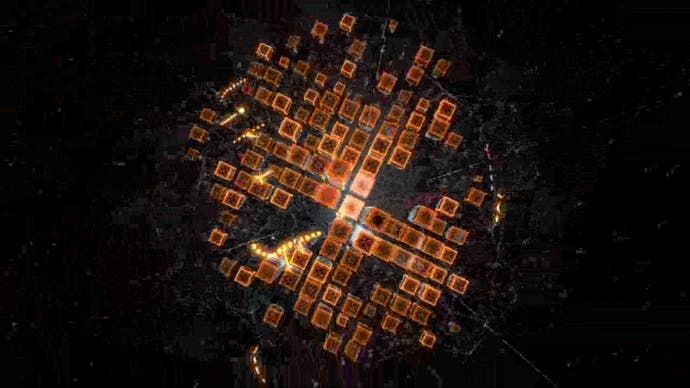

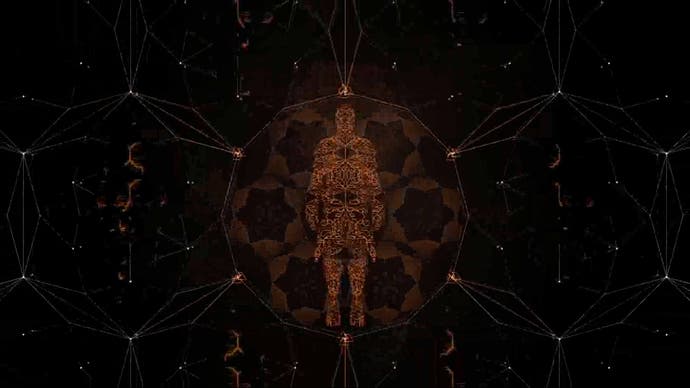
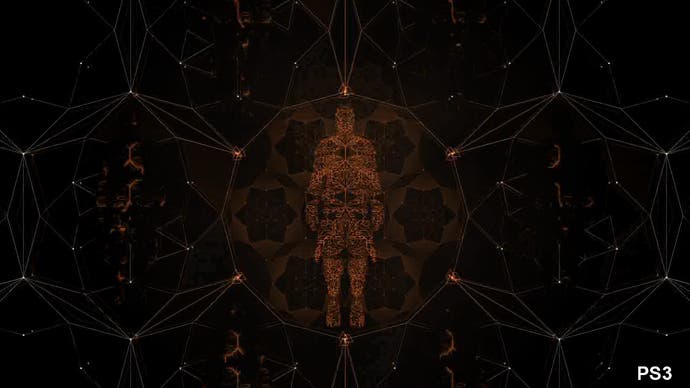
On the flipside, PS3 owners do get the benefit of added sound formats. While Dolby Digital and the archaic Pro Logic II are supported on the 360, the PS3 allows for 7.1 and 5.1 linear PCM formats, along with Dolby Digital and DTS. Given that the game data is mostly identical cross both platforms, it's unlikely that higher quality samples were used for the original music or sound effects with regard to the PS3, although the benefits from having a 7.1 set-up should result in a fuller sound stage with more precise distribution of ambient effects if the mix is handled correctly.
The fact that Syndicate operates at a near rock-solid 30 frame per second on consoles is an impressive feat considering we're talking about hardware that is knocking on for seven years old. But how well does the PC version match up? Does it take full advantage of immensely more powerful hardware to provide a graphically expansive upgrade?
Syndicate PC: It Looks Better, It Plays Better
Starbreeze opts out of supporting the cutting-edge features provided by DirectX 11, instead opting to take full advantage of the older - but still very capable - DX9 API. Utilising DX11 would have required a significant re-write of the core renderer and other aspects of the engine, representing something of a risk given the work involved and time constraints while aiming for a simultaneous multi-platform release. Instead, what we see here is the same baseline tech powering the game, but with a few enhancements making use of the increased processing power and memory capacity afforded by computer hardware.
As our 720p 360 and PC head-to-head video demonstrates, the computer version of Syndicate offers up more of a refinement than a revolution when it comes down to the graphical make-up of the game. For comparison we've also got a PS3 and PC video, for those looking to see how that version holds up.
On a basic level, the core artwork has been upgraded and the visible mip-map transitions when streaming are almost completely gone, although curiously we find that the level of anisotropic filtering has been dialled back compared to the 360, instead appearing to be a closer match to the PS3 game.
Higher resolution textures are used extensively across the characters and environments on PC, along with use of higher quality LOD models both in-game and during the cut-scenes. However, the difference is very subtle when playing, and we get the feeling that the additional detail doesn't really come through as much as we'd hoped given the heavy use of post-processing effects.
When it comes to close-up shots of the characters or certain sections of the environment, the difference is far more pronounced: finer details appear visibly clearer and much crisper, and this is made more obvious when upping the resolution beyond 720p. While texture detail doesn't appear to scale the further you move up the resolution chain, the added pixel precision when running in 1080p means that the benefits gained from the higher quality art are visible from further away, while the post-processing better complements the overall look of the game.
"When it comes to close-up shots of the characters or certain sections of the environment on PC, the difference is far more pronounced: finer details appear visibly clearer and much crisper."

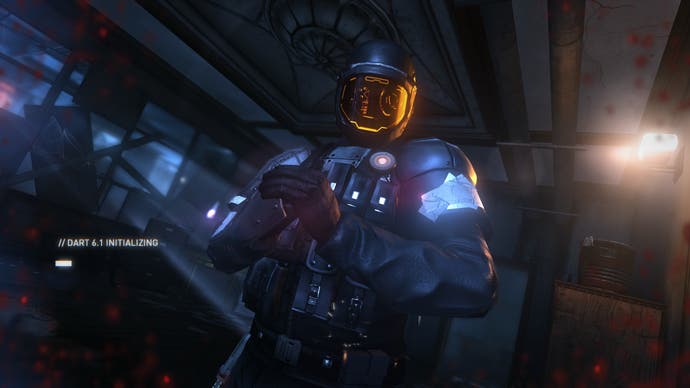
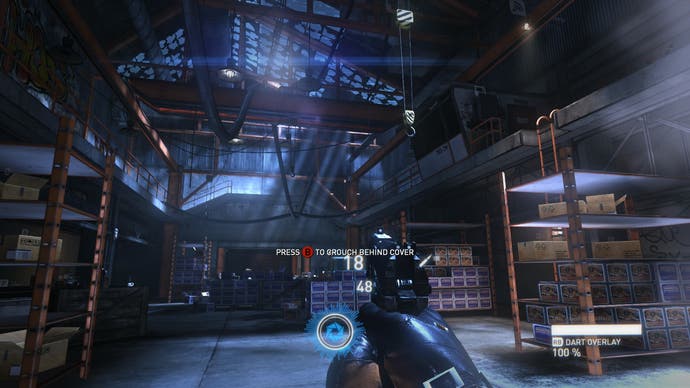

Just like the console versions, Syndicate on PC lacks the use of traditional anti-aliasing, instead relying on a similar post-process edge filter - suggesting the use of a deferred rendering set-up. As such we don't really see a major boost in overall image quality, although we do find that jaggies are reduced by an increase in motion blur. We also find that on a more general level, post-AA's pixel-crawling artifacts are less impactful on image quality at higher resolutions - something the PC version obviously supports.
Elsewhere, we're given the option of using a higher precision framebuffer format in the form of RGBA16 (RGBA8 is also available) allowing for more accurate tone mapping when rendering HDR lighting. Motion blur is also given a higher precision implementation, which is used more liberally than on consoles. The result is an effect that enhances the presentation, delivering an extremely fluid 60FPS, but at the slight expense of raw sharpness - in some sections, the PC version doesn't look quite as clear as the console builds, although this isn't something that can be easily picked up on when seeing the game running in motion. In higher resolutions well beyond 720p, this is barely apparent at all.
The improved frame-rate also has a dramatic impact on the response: the weighty feel when aiming or moving around the environment is reduced, controller response is considerably improved and as a result the game is more fun to play. This isn't something that requires high-end hardware to achieve either: for those looking to power their way past the 30FPS limitations of the consoles or simply match that frame-rate at 1080p, it's pleasing to find that Syndicate should run relatively smoothly on a variety of gaming rigs. We had no trouble getting a solid 60FPS in both 720p and 1080p on a Core i5/GTX 460 set-up, and we'd imagine that lower spec systems shouldn't have too much trouble achieving the latter at 30FPS.
While not delivering a revelatory leap over the consoles in terms of raw detail or the use of additional effects, the jump in resolution and frame-rate alone still goes some way to making the overall experience feel more refined and enjoyable to play. Syndicate on PC doesn't just look better, it plays better too. Even the video sequences seem to be of a higher quality than those in the console builds.
Syndicate: The Digital Foundry Verdict
Starbreeze has concocted a solid, visually alluring first-person shooter with a few carefully crafted ideas and gunplay with a very distinctive kick to it. The blasting is sadistically enjoyable, while the scoring system, unlockable upgrades, and DART-6 abilities all augment this in a fun and interesting manner.
"Syndicate is equally recommended on both console platforms but those looking for the most refined experience would do well to opt for the PC game: it looks better, it plays better."
The game does tend to lose some of its appeal when the player is faced with repeated waves of enemies in the same locale for extended periods - the same room even - before a boss fight, often followed by the appearance of yet more enemies to dispatch. It's here where your DART-6 abilities are of little use, outside of being able to go into slow motion in order to cap off a couple of shots before repeating the process again. Why disable all these upgrades when they could be used as an ingenious way of enhancing such encounters? Elsewhere, the ability to 'breach' drones, terminals, and even people mixes up the gameplay, although this is a concept that is never fully fleshed out.
The good news is that the game's multi-platform conversion has been handled well by Starbreeze. The solid frame-rate is remarkable, the lighting model rather impressive, and besides a few hiccups here and there, the visual differences don't impact the gameplay in any way that compromises the fun of the core experience. While graphical quality favours the 360 game with better texture streaming and consistent 720p resolution, this accounts for little in real-world terms during gameplay: all of the stand-out visual features are there on the PS3, the shadowing is better realised, and the implementation of additional surround sound formats is always welcome.
Syndicate is equally recommended on both console platforms but those looking for the most refined experience would do well to opt for the PC game. The resolution boost and upgraded artwork ensure that playing in 1080p - even at 30FPS - delivers a superior experience compared to the Xbox 360 and PlayStation 3 versions, while a 60FPS upgrade offers a tangible improvement to the way the game actually plays.
